
Rinu Sharma
Guru Gobind Singh Indraprastha University, India
Title: Diagnostic implications of altered miRNA profiles in esophageal cancer
Biography
Biography: Rinu Sharma
Abstract
The asymptomatic nature of esophageal cancer (EC) at early stages of the disease results in late clinical presentation leads to poor prognosis and limited success of therapeutic modalities. Despite advancement in diagnostic and therapeutic strategies, the five year survival rate of the disease still remains less than 20%. This is primarily due to lack of sensitive and specific markers for early diagnosis and monitoring response to therapy for this disease. Hence, there is a pressing need for establishment of novel non-invasive or minimally-invasive biomarkers for esophageal cancer. Growing evidence suggests importance of alteration in microRNA (miRNA) expression in development and progression of cancer. Moreover, presence of miRNAs in various body fluids such as serum, plasma, saliva and urine has opened a new era of disease research. Our group is interested in deciphering the clinical and functional significance of miRNAs in esophageal cancer. We have evaluated the expression of a panel of miRNAs in tissues as well as sera of esophageal cancer patients. The analysis revealed significant dysregulation of these miRNAs in EC tissues as compared to matched distant nonmalignant tissues. Receiver operated curves generated for these miRNAs showed that they possessed significant diagnostic potential individually and as a panel. Moreover, relative levels of circulating miRNAs in serum significantly distinguished EC patients from normal controls with a high sensitivity. The present paper will discuss the individual as well as collective diagnostic potential of these miRNAs and their targets in EC.

